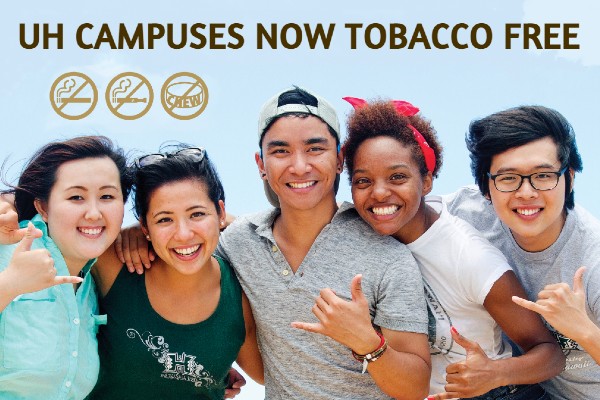Non-Tobacco Products Policy – 2012
A Healthy Kapiʻolani Community CollegePolicy
Kapiʻolani Community College (Kapiʻolani CC) has established a non-smoking, non-tobacco products policy. There is no smoking or the use of tobacco products such as e-cigarettes on campus. This policy was designed by a Tobacco Products Policy Task Force in 2012 that include members of the Student Congress, Faculty Senate, Kalaualani, and the Staff Council. As the main provider of health-related programs in the University of Hawai‘i system, the College instituted this policy to protect students, faculty, and personnel from the effects of secondhand smoke and to support the improvement of the health status of all of the members of the Kapʻiolani CC community.
The Tobacco Products Policy Task Force is distributing material such as the information below to inform the Kapʻiolani CC community of the problems associated with secondhand smoke and the need for everyone to assist in promoting and enforcing the new policy.
What Is Secondhand Smoke (SHS)?
Secondhand smoke (SHS) is a mixture of the smoke given off by the burning end of a cigarette, pipe, or cigar, and the smoke exhaled from the lungs of smokers. This mixture contains more than 4,000 substances, more than 40 of which are known to cause cancer in humans or animals and many of which are strong irritants. Exposure to secondhand smoke is called involuntary smoking, or passive smoking.
How Does Secondhand Smoke Affect My Health?
The U.S. Environmental Protection Agency (EPA) has classified SHS as a Group A (human) carcinogen that is known to cause cancer. EPA estimates that SHS causes approximately 3,000 lung cancer deaths in nonsmokers each year.
What About The Risk To Children?
Secondhand smoke is a serious health risk to children: EPA estimates that passive smoking is responsible for between 150,000 and 300,000 lower respiratory tract infections in infants and children under 18 months of age annually, resulting in between 7,500 and 15,000 hospitalizations annually.
Children exposed to secondhand smoke are also more likely to have reduced lung function and symptoms of respiratory irritation like cough, excess phlegm, and wheezing.
Passive smoking can lead to a buildup of fluid in the middle ear, the most common cause of hospitalization in children for an operation. Asthmatic children are especially at risk: EPA estimates that exposure to secondhand smoke increases the number of episodes and severity of symptoms in hundreds of thousands of asthmatic children.
EPA estimates that between 200,000 and 1,000,000 asthmatic children have their condition made worse by exposure to secondhand smoke. Passive smoking may also cause thousands of non-asthmatic children to develop the condition each year.
What Can I Do To Reduce My Family’s Risk From SHS?
Choose not to smoke in your home and car. Do not allow family and visitors, who are especially vulnerable to health risks, to be exposed to secondhand smoke. Do not allow childcare providers or others who work in your home to smoke. Until you can quit, choose to smoke outside.
Clean Indoor Air Regulation
Although population-based data show declining secondhand smoke (SHS) exposure in the workplace over time, SHS exposure remains a common public health hazard that is entirely preventable. Most state and local laws on clean indoor air reduce but do not eliminate nonsmokers’ exposure to SHS; smoking bans are the most effective method for reducing SHS exposure. Beyond eliminating SHS exposure among nonsmokers, smoking bans have additional benefits, including reduced smoking intensity and potential cost savings for employers. Optimal protection of nonsmokers and smokers requires a smoke-free environment.
